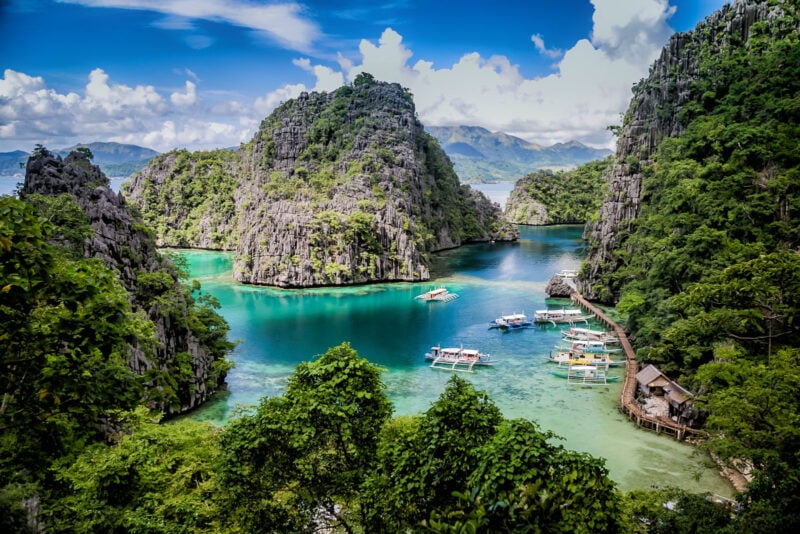The Philippines, a sprawling archipelago boasting over 7,000 islands, beckons with its turquoise waters, vibrant coral reefs, and lush rainforests. But with such diversity comes a question that plagues every aspiring island hopper: when is the best time to visit the Philippines?
Fear not, fellow traveler! I’ve spent countless hours exploring this tropical paradise, and I’m here to guide you through the intricacies of the Philippine seasons. From the dry season’s sunshine to the wet season’s charm, we’ll uncover the perfect time for your dream Filipino adventure.
Best Time to Visit the Philippines (December to April): Sunshine, Serenity, and Celebrations
Let’s start with the crowd-pleaser: the dry season. Spanning December to April, this period offers the quintessential Filipino experience. Imagine yourself basking on pristine beaches, the sun warming your skin as crystal-clear waters beckon you for a swim. Island hopping in Palawan or Cebu becomes a dream, with calm seas allowing you to explore hidden coves and remote sandbars.
The dry season isn’t just about flawless weather. It’s also a time of vibrant festivals. Immerse yourself in the electrifying energy of Sinulog in Cebu, a lively parade honoring the Santo Niño (Child Jesus). In January, Kalibo explodes with color during the Ati-Atihan festival, a riotous display of tribal dance and costumes.

Temperatures during the dry season range from a comfortable 24°C (75°F) to a toasty 31°C (88°F). However, remember that March and April can get hot and humid, especially for those unfamiliar with the tropics.
Pros:
- Minimal rainfall, perfect for beach activities and island hopping.
- Pleasant temperatures (except March-April).
- Vibrant festivals and cultural celebrations.
- Lush landscapes without the heavy downpours.
Cons:
- Peak season means higher prices and larger crowds.
- March and April can be uncomfortably hot and humid.
Insider Tip: While December to February is undoubtedly peak season, don’t discount traveling in May. The shoulder season offers a sweet spot – the crowds start to thin, and the weather remains relatively dry.
The Wet Season Serenade (May to November): Lush Landscapes, Lower Prices, and Fewer Crowds
The wet season in the Philippines, stretching from May to November, might initially seem daunting. But don’t let the rain deter you! This period offers a unique perspective on the islands. The landscapes explode with vibrant greenery, waterfalls cascade to their fullest, and the rice terraces shimmer under a cloak of mist.
The wet season isn’t a constant downpour. The Philippines experiences tropical showers – intense but short-lived bursts of rain, often followed by sunshine. These quick showers cleanse the air and leave the islands feeling refreshingly cool.
Surfing enthusiasts rejoice! The wet season brings bigger waves, making spots like Siargao and La Union havens for catching some epic rides. This is also the best time for scuba diving and snorkeling, as plankton blooms attract a wider variety of marine life.
Travel costs during the wet season plummet as tourist numbers dwindle. However, amazing deals on flights and accommodations remain, making the Philippines an even more budget-friendly destination.
Pros:
- Lush green landscapes and cascading waterfalls.
- Lower travel costs and fewer crowds.
- Ideal season for surfing and diving enthusiasts.
- Chance to witness unique weather phenomena like typhoons (from a safe distance, of course!)
Cons:
- Possibility of encountering heavy rain showers, which may disrupt outdoor activities.
- Some roads and islands might become inaccessible due to flooding.
Insider Tip: The wet season varies in intensity across the Philippines. Places like Palawan have a shorter wet season, while Luzon in the north experiences more frequent rain. Research your specific destination to understand the expected rainfall patterns better.
Beyond the Seasons: Tailoring Your Trip to Your Passions
The beauty of the Philippines is its diversity. Here’s how to choose the perfect time based on your specific interests:
- Festival Fanatic: Aim for January for the Ati-Atihan and Dinagyang festivals or October for the colorful MassKara Festival in Bacolod.
- Scuba Superstar: Head to Palawan or Cebu between November and May for the best visibility underwater.
- Surfing Seeker: Catch the waves in Siargao or La Union during the wet season (May to November).
- Wildlife Wanderer: Spot whale sharks in Donsol from November to May or witness the turtle hatching season in Boracay from October to May
Embracing the Unexpected: Weather Considerations and Packing Tips
The Philippines, like most tropical destinations, throws occasional curveballs. Even during the dry season, a sudden downpour can surprise you. Here’s how to be prepared:
- Download a weather app: Stay updated on real-time forecasts and adjust your plans accordingly.
- Pack light, quick-drying clothes: Opt for breathable fabrics like cotton and linen. Pack a light rain jacket just in case.
- Invest in a waterproof backpack or daypack: Protect your belongings from sudden showers.
- Bring a reusable water bottle: Staying hydrated is crucial, and a reusable bottle minimizes plastic waste.
- Don’t forget sunscreen, sunglasses, and a hat: The sun shines brightly year-round in the Philippines.
- Pack versatile footwear: You’ll be doing a mix of activities, so pack sandals for the beach, comfortable walking shoes for exploring, and waterproof shoes for potential rain showers or hikes.
Beyond the Weather: Cultural Considerations
The Philippines is a deeply religious country, primarily Catholic. Here are some things to keep in mind:
- Dress modestly when visiting churches or religious sites. Shoulders and knees should be covered.
- Be respectful during religious ceremonies. Avoid loud noises or disruptive behavior.
- Learn a few basic Filipino phrases. A simple “Magandang araw po” (Good day) goes a long way in showing respect for the local culture.
The Final Note: There’s No Bad Time to Visit the Philippines
The Philippines is a destination that enthralls throughout the year. Whether you crave sunshine, celebrations, lush landscapes, and budget-friendly travel, there’s a perfect time. So, pack your bags, embrace the spirit of adventure, and get ready to experience the magic of the Philippine islands!
Bonus Tip: While I’ve covered the general trends, remember that the Philippines is a vast archipelago with microclimates. Research your destination to get the most accurate picture of the expected weather conditions.
I hope this comprehensive guide empowers you to plan your dream Filipino adventure. Now, go forth and explore the wonders that await!
See Also:
- Tourist Guide for Shopping in Kalibo, Aklan
- 11 Beachfront Tourist Attractions North of Bacolod
- Top 13 Korean Restaurants in Bohol
- Bohol Nightlife: Top 9 Nightclubs and Bars after Dark
- Things to Do at Brgy. Patag, Silay City
